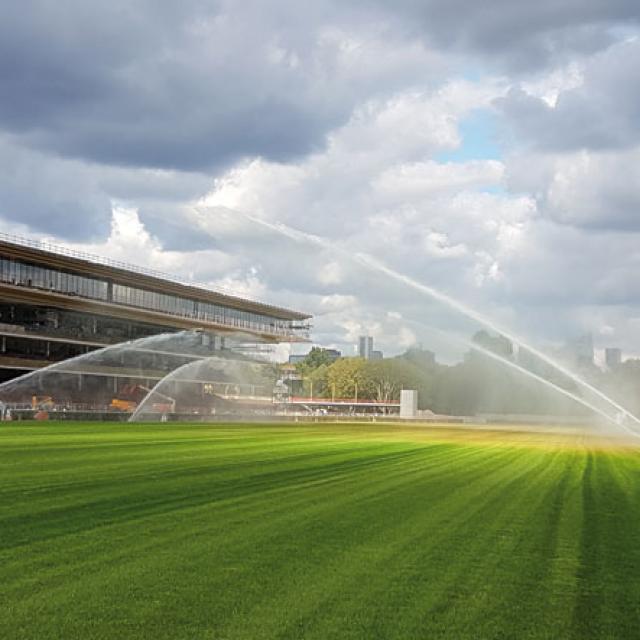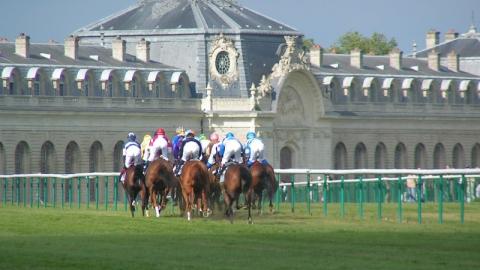The Longchamp racecourse in Paris is one of the most famous in the world. It became well-known in part because it has been the venue of the Prix de l’Arc de Triomphe, the prestigious flat horse race held in October every year since 1920. The finest thoroughbreds, the best jockeys, regardless of where they are the rest of the year, have to be in attendance on that date. The elegance of the site, the quality of its layout and its sheer size (57 hectares in the Bois de Boulogne) make this place the horse racing equivalent of the Eiffel Tower. It is symbolic.

Having been transformed on a number of occasions, the Longchamp Racecourse is currently undergoing major renovation work so as to be fully prepared for the XXI Century. It will reopen its doors to the public for the beginning of the 2018 season, with a new design created by the architect Dominique Perrault. Upmarket private boxes, panoramic restaurants, a grandstand covered by an overlapping and futuristic building constructed of glass shelf-like structures, this major building project created by Bouygues is being undertaken with the aim of improving this exceptional sporting venue, which was built in 1857. The original pavilion stand, located alongside the main site, has been preserved, reminding us of the amazing history of this site.
An unconventional irrigation system
The race tracks are also affected by these changes. The irrigation system and all the pipelines have been replaced. The company Soisy Arrosage is responsible for the irrigation component and the company Hublart is in charge of earthwork and pipework. The building work lasted 9 months, from February to October. Mr. Madelaine, the director of Soisy Arrosage, provides details about the main work carried out.
“We have redesigned the networks, changed the filter stations, central control unit, the sprinklers, where the uniformity must be perfect, and we have installed a specific sprinkler system on the inside of the tracks (on the rope), the section most trampled by the horses” and he continues “With the previous installation, dating back to 1998, the tracks had 30 sprinklers, which were not in sections. The system was effective and it worked well, but we often had a situation where a dry area was being watered at the same time and rate as a wetter area. The irrigation was not uniform”.
The race course was built on a former course of the River Seine, its very fertile sandy soil having the dual advantage of being pliable and safe for the horses, while being very rich in nutrients. Francis Lamotte, the track manager, explains: “The sediments from the Seine and the grass clippings used as mulch restore 200 units of nitrogen per year; thus, we apply very little fertiliser, i.e. only 60 units of nitrogen per year. Over the last two years, we have only used fertilisers once and that was three weeks ago.”
The race course has 4 tracks, including three concentric circles which widen around the ponds:
- The large 2750-metre track, rope on the right.
- The average-sized 2500-metre track, rope on the right.
- The small 2150-metre track, rope on the right.
- The 1000-metre sprint track, which crosses all three in a straight line.
A fifth oval track, built of sandy fibre, is currently being planned. It is expected to be irrigated.
No less than 793 sprinklers have been installed in total. And each zone is provided with a specific irrigation solution, depending on its requirements:
• To irrigate the tracks, 241 Toro 690 and Infinity 835 sprinklers have been installed with a range of 21 to 33 metres. For specific sections, particularly when the track is very large, 60 retractable big gun sprinklers have been laid either side of the tracks, in a triangular layout, with a range of 40 to 50 metres and a coefficient of distribution identical to that of sprinklers with a smaller range.
• On the inside (on the rope), where there is more wear on the turf by the horses, Hunter stainless steel I20 sprinklers with a range of 6 metres are positioned under the surface every 10 metres. “Thus, we can irrigate the area next to the rope, this being the section most used by the horses, without necessarily having to water the rest. And this targeted irrigation of the inside of the track allows for the recovery of the sections of turf that are in the poorest state after a race”, explained Mr. Delporte, the track manager. In fact, this piece of land that with-stands 250 race meetings each year, with 15 to 30 different starting points, is really being put to the test.
Furthermore, all the sprinklers are controlled individually, using a computer-based central control system (Rain Bird Site Control) and a weather station. The sectors and duration of the irrigation can be defined according to the needs and the uniformity of distribution is close to perfection. Mr. Delporte continues: “The turf must be even because the horses could stumble or even worse, they could injure themselves”. Therefore, nothing is left to chance in order to protect the safety of the horses and jockeys. The condition of the tracks is assessed every day with the aid of a soil-testing penetrometer, which identifies whether the soil is firm, heavy or very soft. At Longchamp, the shrine of flat racing, it is essential for the soil to be firm. And even though the weather station gives a good indication, it is always the site manager who has the last word. “During the racing season, in April-May or September-October, we check the weather station four times a day. The surface must be perfect. This now involves a millimetre level of accuracy”, explained Mr. Lamotte, who is responsible for the tracks.
Pumping station – pipework – drainage
With the use of an 800 m3/h pumping station, the untreated water from the Seine, of “average” quality, according to Francis Lamotte, is directed along the existing or specially built pipes. The company Hublart is responsible for earthwork and pipework. In total, after completing the earthwork, 14,740 m of pipes have been laid underneath and outside the tracks. Finally, once the pipes are laid and the trenches backfilled with rubble, the existing turf is re-laid. A fine layer of sand is sometimes used to cover the trenches before relaying the strips of turf, to facilitate surface drainage and promote root growth.
The tracks are drained by a deep drainage system, which is ageing but functional, and there are slit drains, spaced at 45 cm and at a depth 35 cm, which are filled with polystyrenes so as not to injure the horses. Near the pond, where there is a claystone formation, we irrigate a lot less and drainage is imperative.
According to Pierre-Alain Madeleine, “when two firms are working on a site of this scale, it requires good coordination and a lot of understanding and support. We have all pulled together in order to work in the best possible way and complete the project on schedule”.
And Mr. Delporte concluded: “With this system, the site managers can irrigate the recovering areas without having to water all the tracks, which would produce a loss of water (even though it is untreated). In the near future, the managers can expect a 30% saving on water and less irrigation cycles”.
After being closed for two years, the Longchamp racecourse will be reopening its doors in April 2018. However, in the meantime, the 2017 Prix de l’Arc de Triomphe has been held at Chantilly for the second consecutive year.
A history of Longchamp in figure
• Created in 1857
(under the reign of Napoleon III)
• Some thirty meetings per year
• Capacity: 50,000 spectators
• 35 to 40 permanent employees
• 57 hectares, including
17 hectares of turf tracks
• 64 different starting points
Technical specifications:
• Client: France Galop
• Project manager:
K-Consult, irrigation engineering firm
• Contracting firms: Soisy Arrosage (installing sprinklers and remote computerised control),
“Hublart Establishments”
(earthwork and pipework).
• Hand-over of the new racecourse: September 2017
• Cost (irrigation): 1.4 million euros.
Specifications of the irrigation site:
• 793 sprinklers with a range
of 8 to 55 metres
• 14,740 linear metres
of trenches and pipework
• Central control programme with
464 decoders and a weather station
• 800 m3/hour pumping station

